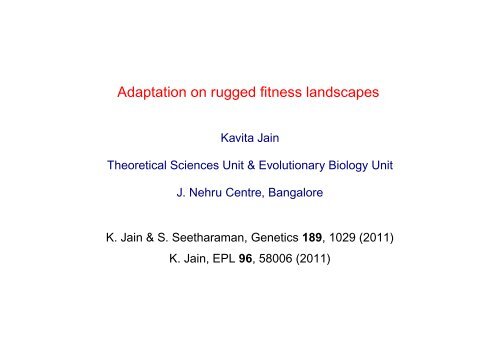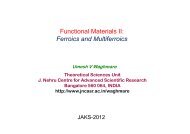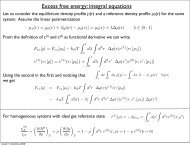Adaptation on rugged fitness landscapes - International Centre for ...
Adaptation on rugged fitness landscapes - International Centre for ...
Adaptation on rugged fitness landscapes - International Centre for ...
You also want an ePaper? Increase the reach of your titles
YUMPU automatically turns print PDFs into web optimized ePapers that Google loves.
<str<strong>on</strong>g>Adaptati<strong>on</strong></str<strong>on</strong>g> <strong>on</strong> <strong>rugged</strong> <strong>fitness</strong> <strong>landscapes</strong><br />
Kavita Jain<br />
Theoretical Sciences Unit & Evoluti<strong>on</strong>ary Biology Unit<br />
J. Nehru <strong>Centre</strong>, Bangalore<br />
K. Jain & S. Seetharaman, Genetics 189, 1029 (2011)<br />
K. Jain, EPL 96, 58006 (2011)
Outline<br />
A model of adaptati<strong>on</strong><br />
- has few parameters, offers a good testing ground<br />
- some theoretical predicti<strong>on</strong>s (Orr, 2002) have been experimentally verified<br />
(Rokyta et al., 2005)<br />
Our results<br />
- analytically calculate quantities of interest<br />
- make experimentally testable predicti<strong>on</strong>s
Adapt or Perish ... (H. G. Wells)<br />
A maladapted populati<strong>on</strong> will either die<br />
Antibiotic Antibiotic<br />
Fit populati<strong>on</strong> Maladapted populati<strong>on</strong> Extinct populati<strong>on</strong><br />
or acquire beneficial mutati<strong>on</strong>(s)<br />
Antibiotic Antibiotic<br />
Fit populati<strong>on</strong> Maladapted populati<strong>on</strong> Adapted populati<strong>on</strong>
Fitness <strong>landscapes</strong><br />
Fitness<br />
Local maximum<br />
Global maximum<br />
‘Genetic sequence’<br />
000<br />
100<br />
010<br />
001<br />
110 011<br />
101<br />
111<br />
Hamming space <strong>for</strong> binary<br />
sequence of lengthL = 3
Climbing the <strong>fitness</strong> landscape (Wright, 1932)<br />
Antibiotic Antibiotic<br />
Fit populati<strong>on</strong> Maladapted populati<strong>on</strong> Adapted populati<strong>on</strong>
Regimes in adaptati<strong>on</strong> dynamics (Jain & Krug, Genetics 2007)<br />
Important parametern: number of mutants produced per generati<strong>on</strong><br />
Ifn ≫ 1: polymorphic populati<strong>on</strong>, scan the whole <strong>fitness</strong> landscape quickly<br />
Populati<strong>on</strong> <strong>fitness</strong><br />
12<br />
10<br />
8<br />
6<br />
4<br />
2<br />
0<br />
Local maximum<br />
1 10 100 1000<br />
time<br />
Global maximum
Regimes in adaptati<strong>on</strong> dynamics (Jain & Krug, Genetics 2007)<br />
Ifn ≪ 1: populati<strong>on</strong> is ‘myopic’, can scan at most <strong>on</strong>e-mutant neighbors<br />
Fitness<br />
‘Sequence space’<br />
Smooth<br />
Rugged<br />
Reaches the global maximum Trapped at a local maximum<br />
In this talk: Uphill walk <strong>on</strong> maximally <strong>rugged</strong> <strong>fitness</strong> <strong>landscapes</strong>
Adaptive walk <strong>on</strong> <strong>rugged</strong> <strong>fitness</strong> <strong>landscapes</strong><br />
Populati<strong>on</strong> walks uphill until it hits a local <strong>fitness</strong> maximum<br />
Populati<strong>on</strong> <strong>fitness</strong><br />
12<br />
10<br />
8<br />
6<br />
4<br />
2<br />
0<br />
Global maximum<br />
Trapped at local maximum<br />
1 10 100 1000 10000<br />
First step in the walk is well studied (Orr 2002; Orr 2006; Joyce et al. 2008)<br />
Statistical properties of the entire walk?<br />
time
Adaptive walk (Gillespie, 1984)<br />
• Need to c<strong>on</strong>sider <strong>on</strong>lyL<strong>on</strong>e-mutant neighbors<br />
• Always walk uphill until no better <strong>fitness</strong> is available<br />
J=4<br />
J=3<br />
J=2<br />
J=1<br />
J=0<br />
<strong>on</strong>e−mutant <strong>fitness</strong><br />
• Transiti<strong>on</strong> probability∝Mutant <strong>fitness</strong>-Current <strong>fitness</strong>
Length of the adaptive walk<br />
In this talk: <strong>fitness</strong>es are independent and identically distributed<br />
Choice of <strong>fitness</strong> distributi<strong>on</strong> motivated by extreme value theory:<br />
p(f) =<br />
⎧<br />
⎪⎨<br />
(1+κf) −1+κ<br />
κ , κ < 0,f < −1/κ<br />
e<br />
⎪⎩<br />
−f , κ → 0<br />
(1+κf) −1+κ<br />
κ , κ > 0<br />
Note that mean ofp(f) is finite whenκ < 1<br />
Average number of steps to a local peak?<br />
Forκ < 1: Average walk length diverges withL<br />
Forκ > 1: Average walk length is a c<strong>on</strong>stant
Length of the adaptive walk: an argument<br />
Transiti<strong>on</strong> probabilityT(f ← h) = Lp(f)<br />
� �� �<br />
sequences with <strong>fitness</strong> f<br />
Forκ < 1: Replace �<br />
T(f ← h) =<br />
g>h<br />
�<br />
h<br />
g −hby an integral <strong>for</strong> largeL<br />
×<br />
f −h<br />
�<br />
g −h<br />
g>h<br />
(f −h)p(f)<br />
: finite <strong>for</strong> f-h∼ O(1)<br />
dg(g −h)p(g)<br />
Walk goes <strong>on</strong> indefinitely <strong>for</strong> infiniteL<br />
Forκ > 1: Replace �<br />
g>h g −hby largest term∼ Lκ &Lp(f) ∼ O(1)<br />
T(f ← h) ∼<br />
f −h<br />
L κ : finite <strong>for</strong> f-h∼ O(L κ )<br />
Since local optimum also has <strong>fitness</strong>L κ , walk terminates
Adaptive walk <strong>for</strong>κ < 1<br />
PJ(f) = Prob(<strong>fitness</strong> isf at theJth step in the walk)<br />
Recursi<strong>on</strong> equati<strong>on</strong> <strong>for</strong>PJ(f):<br />
PJ+1(f) =<br />
where<br />
J<br />
� f<br />
0<br />
dh<br />
h f<br />
(f −h)p(f)<br />
� u<br />
dg(g −h)p(g) h � �� �<br />
(1−q L (h))<br />
� �� �<br />
Prob(<strong>fitness</strong>>h available)<br />
Transiti<strong>on</strong> prob ∝ <strong>fitness</strong> gap<br />
q L (h) = Prob(n<strong>on</strong>e are better thanh) =<br />
�� h<br />
0<br />
dgp(g)<br />
�L<br />
PJ(h)
Adaptive walks are short<br />
Average walk length<br />
Average walk length ≈<br />
7<br />
6<br />
5<br />
4<br />
3<br />
• Uni<strong>for</strong>m distributi<strong>on</strong>, α=2/3<br />
• Exp<strong>on</strong>ential distributi<strong>on</strong>, α=1/2<br />
� �<br />
1−κ<br />
lnL, κ < 1<br />
2−κ<br />
10 100 1000 10000<br />
L
Entire adaptive walk: experiments (Gif<strong>for</strong>d et al., 2011)<br />
20 replicate populati<strong>on</strong>s of A. nidulans evolved <strong>for</strong>800 generati<strong>on</strong>s<br />
Fitness (growth rate) of the col<strong>on</strong>y measured<br />
For different initial c<strong>on</strong>diti<strong>on</strong>s, counted substituti<strong>on</strong>s until <strong>fitness</strong> saturated
Average walk length: experiments (Gif<strong>for</strong>d et al., 2011)<br />
(i) about2steps l<strong>on</strong>g (ii) independent of initial c<strong>on</strong>diti<strong>on</strong>s<br />
Suggestsκ > 1 in A. nidulans. This needs experimental verificati<strong>on</strong>
Summary<br />
• Described a model of adaptati<strong>on</strong>; requiresLandκ<br />
• Theoretical result <strong>on</strong> the number of steps to a local <strong>fitness</strong> peak<br />
Other results<br />
• Assumpti<strong>on</strong> of independently distributed <strong>fitness</strong>es can be relaxed<br />
• Certain distributi<strong>on</strong>s can be computed







